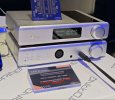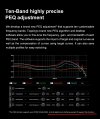staticV3
Grand Contributor
- Joined
- Aug 29, 2019
- Messages
- 12,734
- Likes
- 21,258
On the website: https://www.toppingaudio.com/product-item/d50-iiiI think I'm a bit clumsy,
I can't find "Topping Tune" where
is it?
On the website: https://www.toppingaudio.com/product-item/d50-iiiI think I'm a bit clumsy,
I can't find "Topping Tune" where
is it?
ThanksTopping D50 III version V1.37 firmware update
September 5, 2024
Link: https://www.toppingaudio.com/download/d50-iii-v1-37gu-jian-sheng-ji-2
You find it written when the archive downloads.Thanks
What does it bring ?
Yes, the screen backlight is always On with a small dot in the corner. And it is indeed an LCD type screen.The whole screen emits some light just because of the dot in the corner is active. This is typical LCD behavior with no mini-LED zones.
I find that USB issue really confusing. Does it mean you can only "download" the PEQ into the D50lll using the USB or can only use the PEQ settings on your stereo for example when using your usb settings. The manual states you can only use the USB to upgrade firmware. Really confusing and the instructions are terrible.AFAIK the D50 III only supports PEQ on its USB input.
With offline, they probably mean without an active connection to Topping Tune, meaning that you can configure the PEQ on one PC, store it onto the DAC, then use that PEQ on another PC, Mac, or Linux.
@Rja4000 should be able to tell us more once he tests the PEQ function.
The D50III can only apply EQ to USB audio.I find that USB issue really confusing. Does it mean you can only "download" the PEQ into the D50lll using the USB or can only use the PEQ settings on your stereo for example when using your usb settings. The manual states you can only use the USB to upgrade firmware. Really confusing and the instructions are terrible.
Have you received confirmation of this feature on the new D90 III Discrete?If you want to EQ SPDIF or Bluetooth, then you'd need the D90 III Discrete
This was already confirmed back in March when Topping attended Canjam in New York:Have you received confirmation of this feature on the new D90 III Discrete?
 www.toppingaudio.com
www.toppingaudio.com


Hi @Rja4000 !Intersample overs
As I usually do now, I tested for intersample overs, up to +3dB overload, and distortion is showing only above +2.8dB or so.
This is excellent performance, and much better than the other Topping ESS DACs I have measured, almost on par with the RME performance.
I don't know if Intersample overshoots are actually a problem in real life, but not with this DAC anyway.
View attachment 363681
Hi @Rja4000 !
First off, thank you so much for your excellent review of the Topping D50 III, and for including Intersample Overs testing within the review. Although prevalence (and audibility) of these artifacts is still quite contentious, I am glad that you provide objective data to help people make informed purchase and setup decisions.
This issue was recently resurfaced for me when I watched a fascinating presentation by John Siau of Benchmark Media hosted on the Audioholics YouTube channel last night: Intersample Clipping - A Problem with Most Digital Playback Systems?
This then led me to reevaluate one of my setups, which is based on the Topping D90LE, which you include as a comparison point in the test results. I recall that in the initial review thread for the nearly-identical D90SE, John Yang stated (post #378) that the DAC was built to handle intersample peaks in real music but not square waves. Judging from your data in the OP, this can be translated to building around 1.3 dB of additional headroom to handle these peaks.
Given that a good chunk of recorded music exists with intersample overs upwards of +3dB FS, I wanted to look into optimal mitigation strategies for my personal IEM setup, which currently consists of a Topping D90LE DAC, A90 Discrete headphone amplifier, and a few IEMs including the Thieaudio Monarch Mk II.
Obviously if your source supports digital level control, one could simply trim the output -2dB (corresponding to 88% on the Windows 11 volume slider) and end up with effectively 3.3 dB of headroom total. Similarly, on the D50 III, you could just trim the output by 1/2 dB and end up with approximately the same headroom. However, not all sources support digital level control, so this isn't always an option for everyone.
I then remembered that the D90LE has two usage modes: DAC mode and Preamp mode, the latter of which differs by allowing the user to define an output level via digital volume control. However, without direct testing or a circuit diagram, it is impossible to know whether the internal topology of the D90LE (or D50 III) places the digital volume control before or after the interpolator in the digital signal chain. In other words, there is no way to predict (without testing) whether setting these DACs to preamp mode and adjusting the digital volume can adequately handle these intersample overs.
If you have a spare moment (and if you still have the D90LE at your disposal), could you please test whether setting the unit to preamp mode and setting the level to -2dB gives the expected 3.3 dB of dynamic headroom for these intersample overs? Also, I don't suppose you have a miniDSP Flex to test as well, do you? That unit is the foundation for another system of mine (alongside 2x Topping B200, 2x Ascend Sierra LX, 2x SVS SB-3000) and I'd be curious to see its behavior given that it uses a very different processor.
Thank you for the thoughtful reply! That was actually my initial thought as well, and the first thing I tried as soon as I watched John Siau's presentation. That said, I did this with a sine wave, not a square wave, given that the issue is that sine waves are clipped to resemble square waves when there are ISPs that exceed 0dBFS.Correct me if I'm wrong (I'm not an expert and I've never done measurements) but I believe you can easily make these tests yourself.
1) Run a band-limited 0dBFS square wave file at FS/4 into the DAC and out into an audio interface. Remember to turn off or disconnect speakers and headphones (they'll implode otherwise).
2) Record the signal using Audacity or any software of your choosing.
3) See if it clips. If it does, lower the DAC volume. If it doesn't clip anymore then the volume is placed before the oversampling step. If the wave is still clipped then you have to solve the problem at the source by lowering the volume in the OS or by oversampling your music in software.
EDIT: Typos.
EDIT2: Also, it might be a good idea not to run the DAC output at full volume to avoid overloading the interface's inputs. You'd still be able to tell if the wave is clipped or not.
I take it this will be the same for the D50 III then?@tccalvin - Following up to say that using a different test tone generator (Multitone Analyzer), I was able to correctly generate a tone that resulted in inter-sample clipping on the D90LE when Windows was set to 100%.
As expected, setting Windows to 88% (-2dBFS) solved this issue. But at this point, this "fix" was only guaranteed for sources with digital level controls.
Once I knew I was able to detect (and fix) the problem on the source side, I switched the D90LE to preamp mode at -2dB level. Fortunately, adjusting the digital level on the DAC side also fixed the issue, leading me to infer that the digital volume control is indeed situated before the interpolator.
There's no way to know for certain without directly testing, but I suspect that would be the case, given they are from the same manufacturer.I take it this will be the same for the D50 III then?